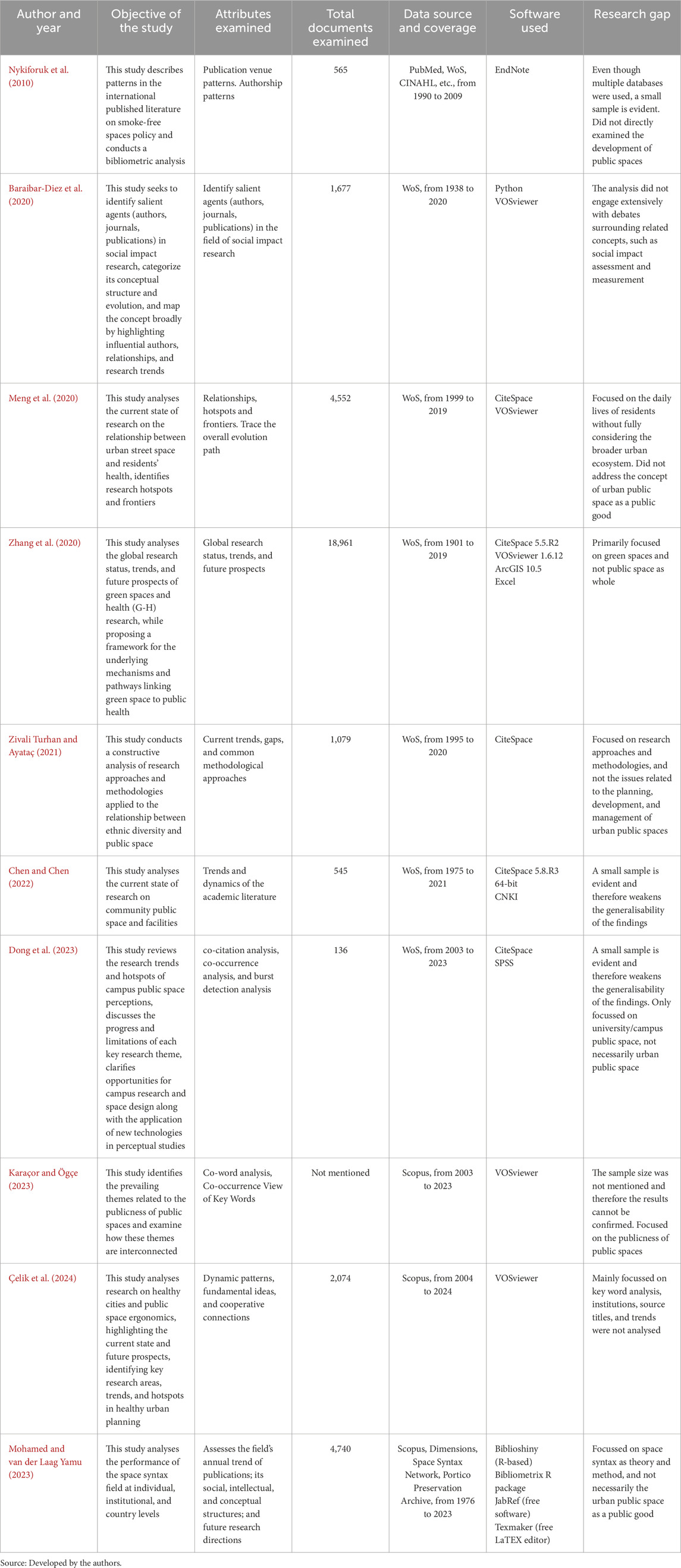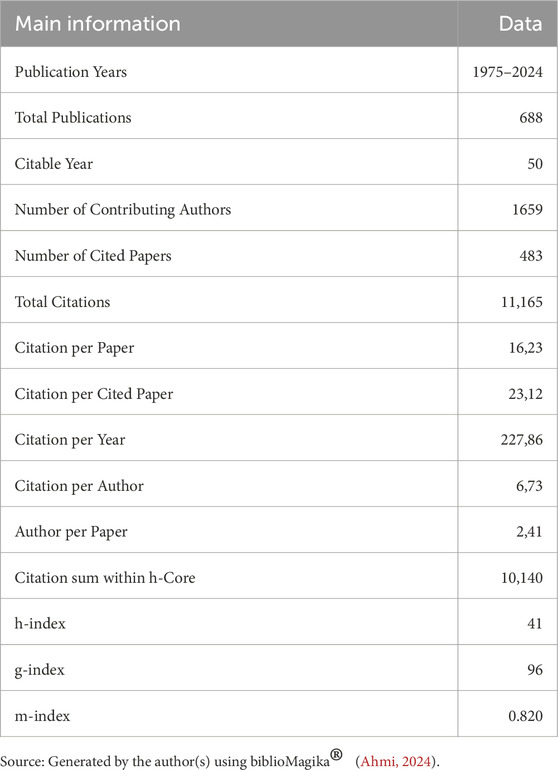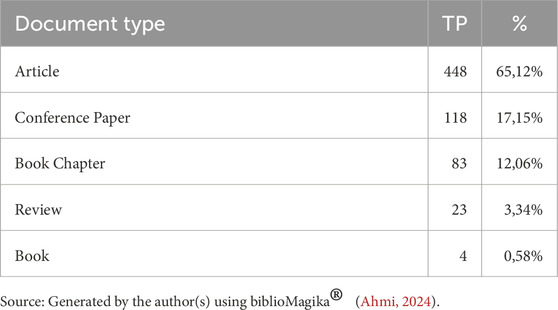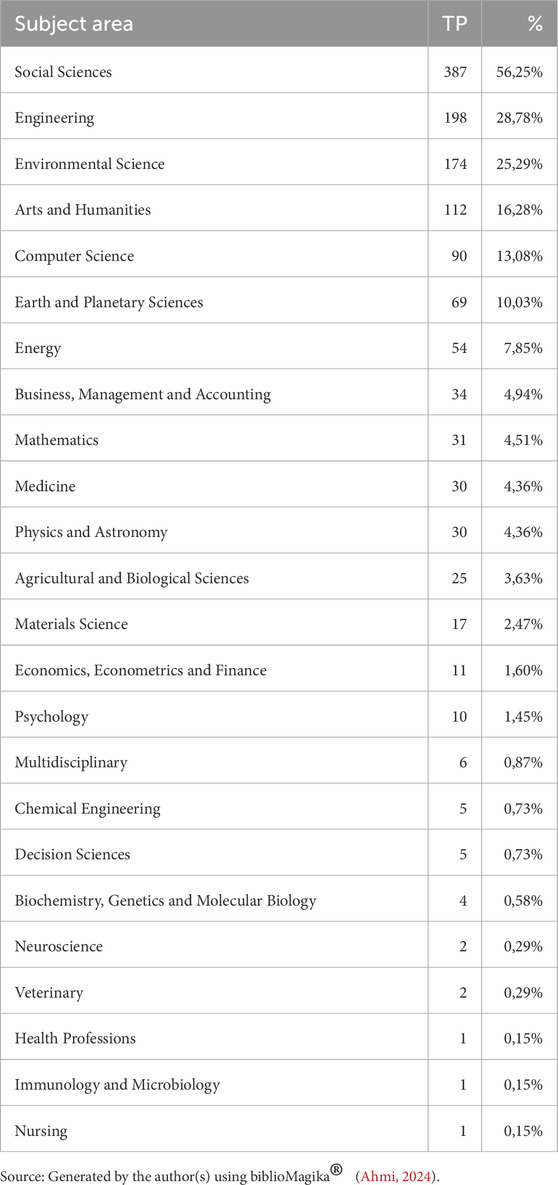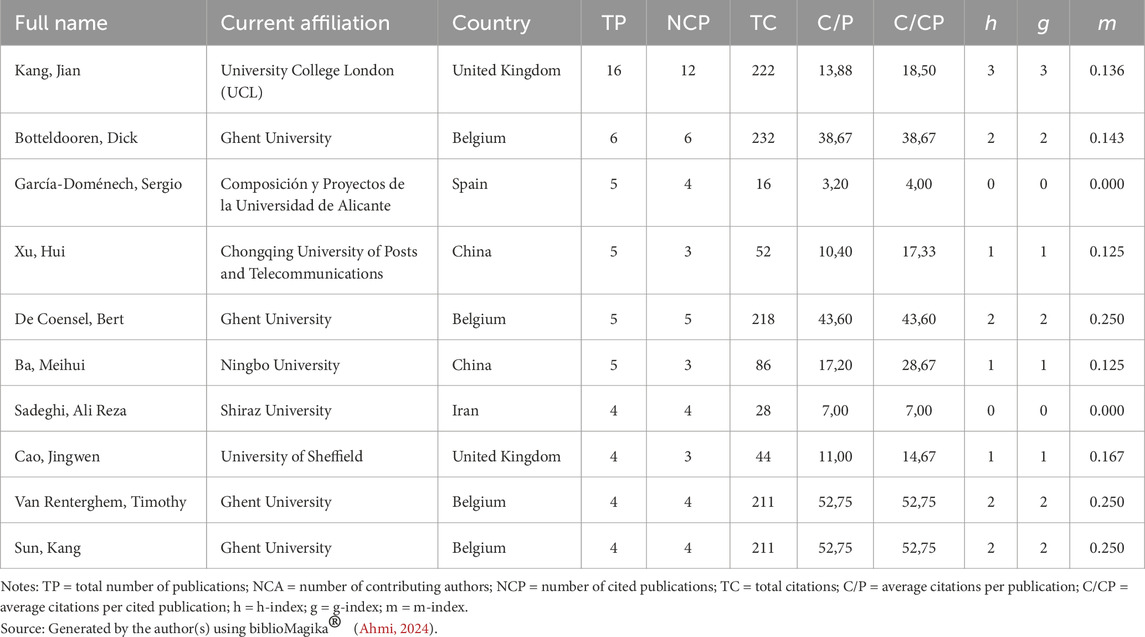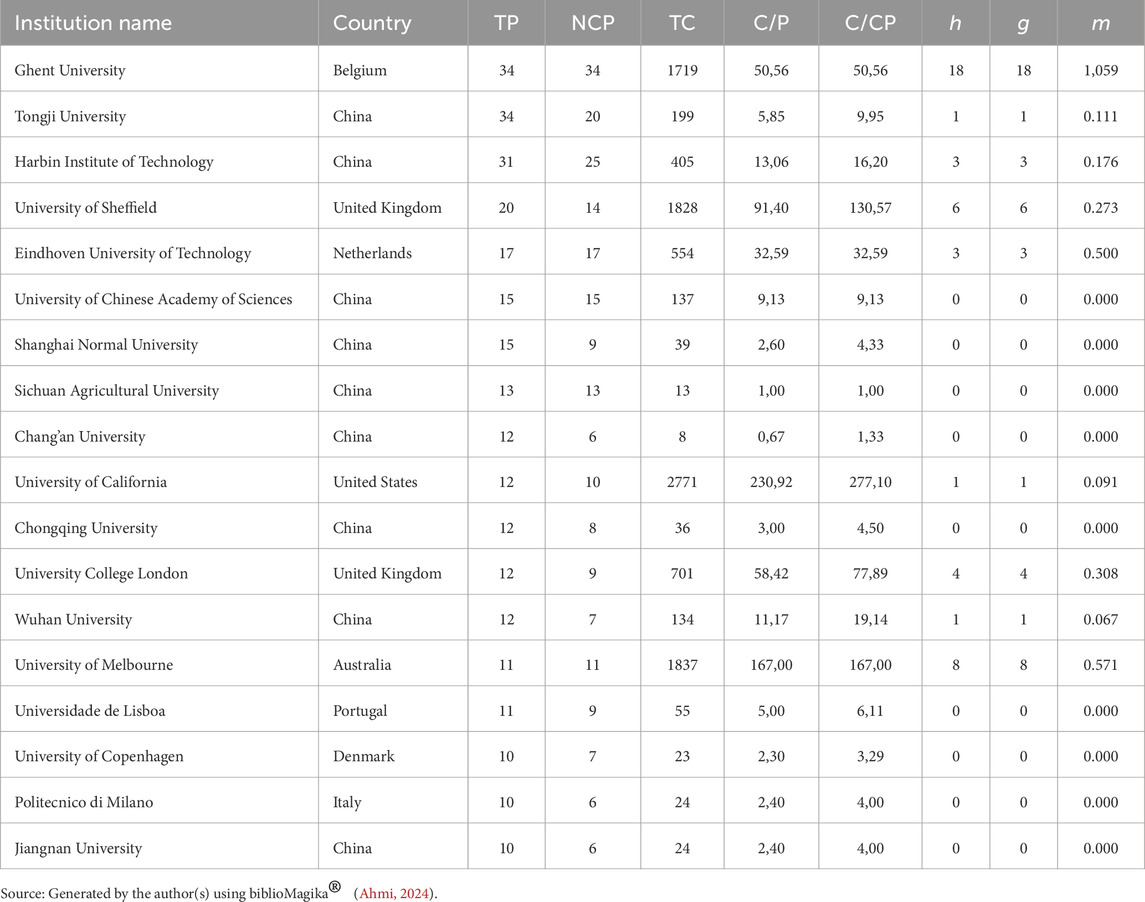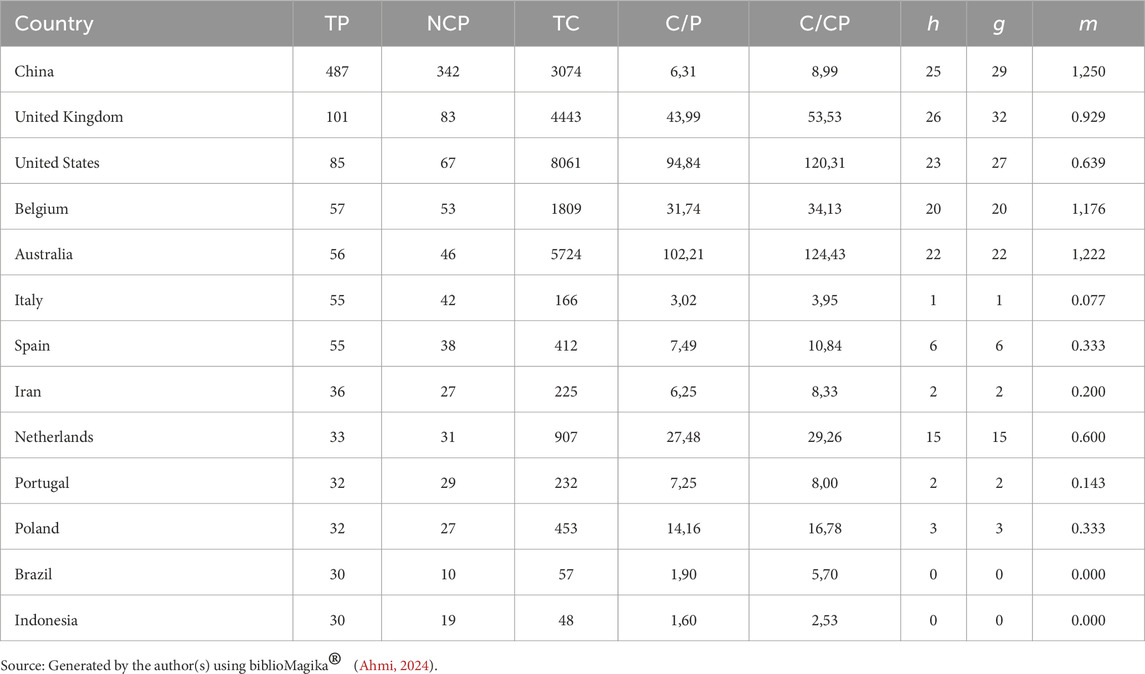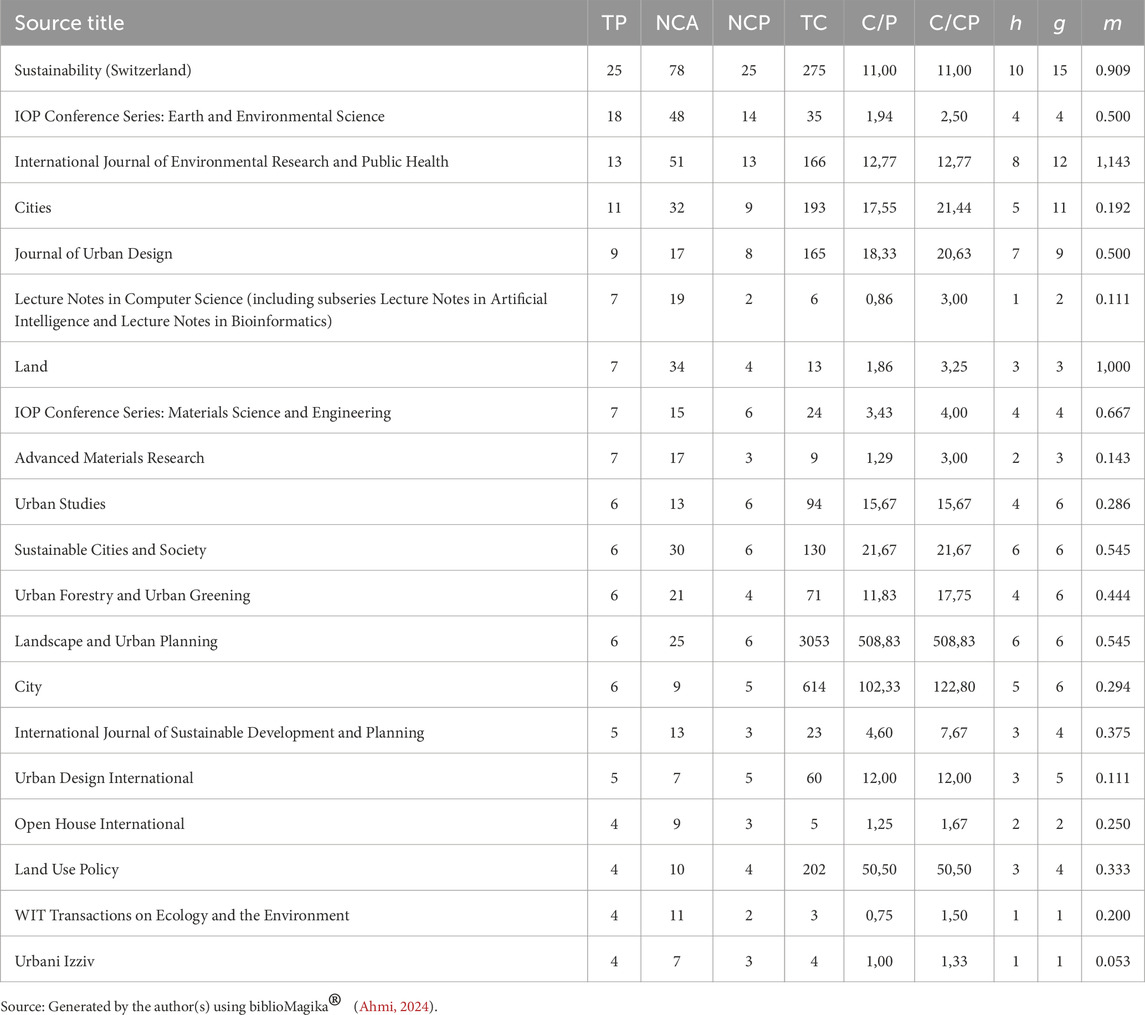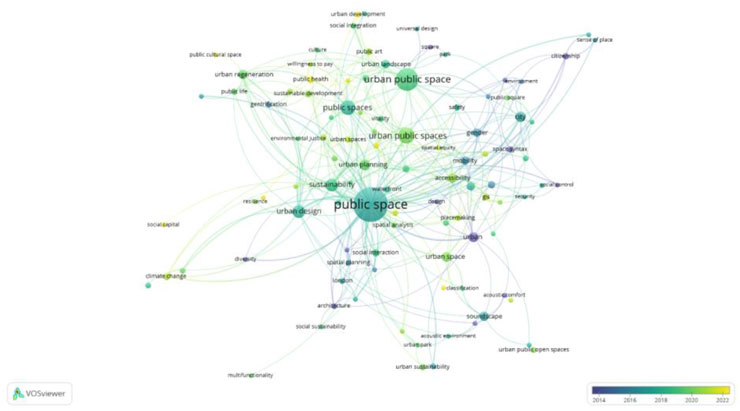- 1Department of Construction Management and Quantity Surveying, University of Johannesburg, Johannesburg, South Africa
- 2Department of Building and Human Settlement Development, Nelson Mandela University, Gqeberha, South Africa
- 3Department of Science, Technology, and Innovation, Pretoria, South Africa
A considerable body of research focusing on urban public space development has been published over the years in numerous academic journals internationally. This study reviews global research trends on this domain, driven by ongoing debates about whether these spaces fulfil their intended purposes. Its main goal is to map scholarly discourse on this topic in the 21st century, identifying key themes, emerging patterns, and changes over time. Understanding these trends is important for recognizing knowledge gaps, guiding future research, and informing urban planners and policymakers about challenges and opportunities in public space development. The study uses BiblioMagika and VOSviewer as bibliometric approaches to analyse 688 documents published from 1975 to 2024 sourced from the Scopus database. Advanced tools, including keyword co-occurrence, trend analysis, and multiple correspondence analysis, support a detailed exploration of the field. The findings reveal that there has been a significant upward trajectory in research output, beginning with a single publication in 1975 and culminating in 2023 with 76 publications. Kang Jian from the University College London in the United Kingdom is revealed to be the leading scholar and Ghent University in Belgium emerges as leading institution in this domain. Although limited to a single database, the research offers a comprehensive temporal and thematic overview of academic work on urban public spaces. Its findings are valuable for scholars, practitioners, and decision-makers seeking to align future research and urban planning strategies with current developments in the field.
1 Introduction
Urban public spaces constitute an essential component of urban infrastructure, and when designed in an inclusive and sustainable manner, they can contribute to mitigating antisocial behaviours within cities. The resurgence of interest in the potential and opportunities inherent in urban environments (Haas and Olsson, 2014) has prompted increased investments in the design, upkeep, security, and governance of public spaces. This renewed focus has also stimulated scholarly inquiry and professional engagement among academics and built environment practitioners. Through publications, scholars can access, build upon or advance and share knowledge for the betterment of UPS development. A systematic analysis of articles from academic journals could assist emerging academics to explore the status and future trends in this field (Ke et al., 2009). Despite a growing body of literature on UPS development, existing studies are largely fragmented, thematically narrow, or geographically limited–often focusing on specific case studies, regions, or thematic subsets such as green space or public health. There is a lack of comprehensive, longitudinal bibliometric synthesis that maps the global scholarly landscape of UPS development, including thematic evolutions, leading contributors, and institutional trends.
Building on this gap, the following hypotheses are proposed to guide the bibliometric analysis: 1) there has been a significant increase in global academic output on UPS development since 2000, reflecting growing scholarly interest in sustainable and inclusive urbanism, 2) a small number of authors and institutions dominate scholarly output and citation in UPS development, indicating a concentration of influence, 3) research on UPS development is thematically evolving, with a shift from basic spatial design to emerging issues like equity, health, and smart cities, 4) the Global North, particularly countries like China, the UK, and the US, leads in publication volume, while the Global South remains underrepresented. This study, therefore, aims to contribute to the existing body of knowledge concerning UPS development by analysing the research trends using a comprehensive review approach which incorporates scientometric analysis. Through this, the study aims to.
1. To ascertain the annual number of articles published, the focus of each article and its impact (citation) to the field.
2. To determine the most influential authors, organisations, and countries in UPS development.
3. To ascertain the research themes that authors focused on over the years.
4. To propose directions for future research on UPS development.
This study presents a novel, large-scale scientometric analysis of 688 global publications on urban public space development sourced from Scopus, spanning nearly 5 decades (1975–2024). Unlike prior studies which were limited in scope, region, or theme, this research provides a comprehensive and temporal cartography of global urban public space development discourse, revealing gaps in underrepresented regions and identifying the most influential contributors and thematic shifts over time.
2 Literature review
2.1 Empirical studies on urban public space development
Public spaces play a critical role in shaping urban development, serving not only as physical spaces for recreation and interaction but also as arenas for social, political, and economic expression. Theoretically, scholars like Henri Lefebvre have deeply influenced how we conceptualize public space within the broader framework of urban development. This theoretical lens positions public spaces as both products and drivers of urban development, making their planning and governance central to creating inclusive, resilient, and just cities. The concept of “right to the city,” introduced by Henri Lefebvre, has become a significant framework for analysing urban processes and challenging capitalist urbanization (Butler, 2012). Lefebvre’s theory emphasizes the social production of space and the importance of everyday life in shaping urban environments (Butler, 2012). However, when applying this concept to cities, it is crucial to consider the role of race in urban geographies (McCann, 1999). The right to the city has attracted attention from both radical theorists and UN agencies, creating a conceptual vortex that brings together diverse political projects (Kuymulu, 2013). While Lefebvre’s formulation, based on the contradiction between use value and exchange value in capitalist urbanism, remains valuable for analysing urban politics, it also reveals certain limitations in his account (Kuymulu, 2013). The concept continues to evolve, inspiring debates on spatial citizenship and the development of antiracist urban public spaces (Butler, 2012; McCann, 1999).
Public spaces serve as fundamental components of democratic societies, acting as central arenas for urban interactions and fostering social cohesion through diverse encounters and cultural exchanges (Pancholi, Yigitcanlar and Guaralda, 2015). These spaces facilitate engagement among different social groups by providing a physical setting that enables interaction and mutual exposure (Smith and Steino, 2016). The creation of inclusive and sustainable public spaces necessitates an integrative approach that balances environmental, social, and economic considerations to enhance communal wellbeing (Nikšič and Sezer, 2017). High-quality public spaces are characterized by participatory planning processes, ensuring community involvement before implementation, as well as inclusive infrastructure development, maintenance, and management that prioritize accessibility. Furthermore, public spaces should be designed to promote openness and accessibility, thereby accommodating diverse populations and fostering inclusivity (Smith and Steino, 2016). The development of suitable public space solutions or the enhancement of existing spaces is essential for fostering social cohesion, justice, and equality. However, the success of public spaces is not solely dependent on shared usage but rather on the transformative potential they offer within their urban context (Smith and Steino, 2016). This necessitates a holistic approach that effectively integrates design and management within the framework of urban policies (Pancholi et al., 2015). Consequently, the redevelopment of urban public spaces has become a critical aspect of city architecture (Arboix and Martín, 2017), requiring a specialized discipline and systematic study to assess their characteristics and inform strategic interventions.
The revitalization of existing public spaces, along with the development of new ones, is anticipated to foster social interactions and generate shared benefits, thereby enhancing the collective sense of place. The urban environment comprises both private and public domains, encompassing buildings, streets, squares, landscapes, and ecosystems, as well as the sociocultural processes, perceptions, and individuals that contribute to its formation and transformation (Haas and Olsson, 2014). These spaces include marketplaces and religious precincts, which hold significant communal value (Smith and Steino, 2016). Public spaces serve as the setting for social engagement, where urban life unfolds through interactions in streets, squares, and parks, shaping the rhythms of human activity (Haas and Olsson, 2014; Zhao and Ji, 2018). Such dynamic spaces not only complement the more stable settings of work and domestic life but also facilitate movement, communication, and shared recreational experiences. The current public spaces and buildings lack a coherent urban strategy and function primarily as commodities rather than spaces that foster social interaction. They are often perceived merely as physical enclosures rather than as dynamic, inclusive environments that contribute to urban life. Instead of facilitating shared experiences, these spaces are enclosed and isolated from the broader urban fabric. In many developing countries, the universal accessibility of public space has been supplanted by commercialization, effectively diminishing its public function. Consequently, the process of redesigning public spaces has become increasingly challenging, with significant implications for the spatial configuration of contemporary cities. These challenges influence not only the physical structure of urban environments but also determine who can access and utilize these spaces, under what conditions, and for whose benefit. Furthermore, they shape the broader discourse on modern citizenship and urban inclusion (Mitchell, 2014; Dong et al., 2017).
Haas and Olsson (2014) contend that the concept of public space lacks analytical precision and is instead a broad and ambiguous term applied to specific urban areas for political or administrative purposes. They argue that public space can be understood as infrastructure and, consequently, a public good, contingent upon its users and their interactions with it. Built structures do not inherently function as infrastructure but acquire this status based on their usage. The extent to which exclusion or competition occurs influences whether a particular built environment or public space is perceived as infrastructure or a public good.
In the broader academic discourse, Carmona (2015) identifies several recurring criticisms concerning urban public spaces, highlighting that, professionals responsible for their design, development, and management face scrutiny. These critiques encompass issues such as neglect, encroachment, exclusion, commercialization, privatization, segregation, insularity, artificiality, insecurity, and homogenization in contemporary urban settings. Similarly, Smith and Steino (2016) assert that architects and designers are often held accountable for the dysfunctionality observed in urban public spaces.
The conceptualization of public space as a common good is widely acknowledged; however, this perception is often based on presuppositions rather than critical inquiry. For urban spaces to be genuinely regarded as public goods, they must be universally accessible and inclusive, thereby serving the collective interests of society (Haas and Olsson, 2014). Nevertheless, spatial design alone is insufficient in addressing the deeper socio-economic challenges that hinder the development of dynamic communities and a thriving public space culture (Pancholi, Yigitcanlar and Guaralda, 2015). Pancholi et al. (2015) further identify key attributes that define high-quality public spaces, which include meaningfulness, democratic accessibility, responsiveness, comfort, and engagement—both passive and active. Additionally, such spaces should foster exploration and discovery (Haas and Olsson, 2014; Zhao and Ji, 2018) while embodying diversity, compatibility, adaptability, intensity, and recognition. The equitable and dynamic development of public spaces is fundamental to urban growth. Southworth (2014), in his discussion on “public life, public space, and urban design,” argues that the provision of public spaces is increasingly perceived as a financial burden by many cities and suburban areas. He further emphasizes that merely designing physical spaces does not guarantee vibrant public engagement. Instead, urban designers must anticipate how these spaces will be utilized and integrate elements that encourage social interaction, public celebrations, and communal activities. Additionally, Southworth (2014) contends that reimagining the regulatory framework governing urban activities can be just as significant in fostering public life as the spatial design itself.
The designer’s role in supporting the public realm has evolved to encompass the engagement of diverse stakeholders in the creation and activation of urban spaces. To effectively utilize the knowledge of residents, the conventional architecture design process must undergo transformation. Collaboration between architects and experts from social disciplines is critical to understanding the needs of space users and gathering pertinent information for designing functional spaces. The built environment reflects the expectations and aspirations of the people who inhabit and work within it. Thus, architects and designers are tasked with addressing a broad spectrum of human needs, including physical, cultural, and social considerations. Public participation, a concept that pertains to social engagement during the planning phase rather than during implementation, now includes a wide array of practices and collaborative processes that tackle both physical and social planning issues (Lewandowska, 2018). Furthermore, as Lewandowska (2018) suggests, sociologists serve as an essential bridge between architects and space users. Gaining an understanding of space usage and the expectations of inhabitants is critical. Social media has been identified as one of the most effective tools for engaging the public in the planning and design process, as noted by Simm et al. (2016) and Southworth (2014). Organizations increasingly utilize digital tools, including social media platforms, to gather public opinions on a wide range of topics, from brand image to political discussions. The urban environment, including public residential spaces, is inherently complex, dynamic, and unpredictable, particularly in terms of its physical characteristics. In their analysis of the integration of physical environments into public space design, the authors introduced various computer software programs that simulate and technically explain the physical environment and spatial structure. They argue that such simulations offer a valuable framework for evaluating the overall suitability of a design, providing practical guidance for subsequent design stages (Dong et al., 2017). This approach contributes to determining the land-use suitability for entirely public spaces.
Building upon the land use considerations and strategies for sustainable urban forms outlined above, it can be contended that the enhancement of public space within cities plays a pivotal role in improving the urban living environment, enriching the cultural fabric of the city, and advancing its overall quality (Zhao and Ji, 2018). In high-density urban settings, it is feasible to develop public spaces that align with human environmental behaviours, accommodating diverse urban lifestyles. By expanding the availability of public space and optimizing its structure, the quality of such spaces can be significantly enhanced. Furthermore, integrating urban facilities, enhancing public spaces, improving transportation conditions, and preserving historical landscapes contribute to shaping the urban form. The responsibility for the design of public space lies with architects across municipal, private, and academic sectors (Arboix and Martín, 2017), particularly in ensuring that urban infrastructure is designed to create inclusive spaces, accessible to all, and serving as venues for the expression of civic identity. Cities are experiencing a rapid evolution of public spaces (Haas and Olsson, 2014), driven by factors such as economic and cultural globalization, demographic shifts, urban planning and design strategies, and social networks, among others. The global dialogue surrounding the development of urban public spaces calls for a thorough examination of contemporary research trends through a comprehensive review process. This process should incorporate scientometric analysis to systematically assess the scope, impact, and future direction of research in this domain. By utilizing scientometric techniques, it becomes possible to map the intellectual landscape of the field, identify emerging themes, and evaluate the contributions of various studies and scholars to the development of urban public space theory and practice. This approach will facilitate a deeper understanding of current challenges in the development of urban public spaces.
2.2 Previous studies on bibliometric analysis and urban public space development
In recent years, scholars have increasingly utilized bibliometric techniques that align closely with the methodological approach adopted in this study. However, there is no documented evidence of any bibliometric analysis conducted in the field of urban public space prior to 2010. From Table 1 below, it is evident that the earliest documented study in this field was authored by Nykiforuk, Osler, and Viehbeck, and published in 2010. This study aimed to document and synthesized research trends in smoke-free spaces policy from 1990 to 2009, analysing patterns to understand the evolution of this domain within the broader context of tobacco control. However, the analysis was limited to literature from North America, the United Kingdom, and Australia, excluding contributions from developing countries. Additionally, the connection between the literature and shifts in policy priorities remains ambiguous, with the precise nature of this relationship not fully understood. This study did not discuss any issues related the planning, development, and management of urban public spaces.
A decade later, a study conducted by Baraibar-Diez et al. (2020) was published, focusing on identifying key agents (i.e., authors, journals, and publications) in social impact research spanning the period from 1938 to 2020. Again, the analysis did not engage extensively with debates surrounding related concepts, such as social impact assessment and measurement. In the same year, Meng, Wen, Brewin, and Wu published a study that analysed the current state of research on the relationship between urban street space and residents’ health, identifying key research hotspots and frontiers from 1999 to 2019. However, the study was limited in scope, primarily focusing on the daily lives of residents without fully considering the broader urban ecosystem. Furthermore, it did not address the concept of urban public space as a public good. Zhang et al. (2020) published a study that aimed to analyse the global research status, trends, and future prospects of green spaces and health (G-H) research. The study further sought to propose a conceptual framework outlining the underlying mechanisms and pathways through which green spaces impact public health. This study, however, primarily focused on green spaces and public health within developed regions, addressing the broader development of urban public spaces, particularly in relation to underdeveloped and developing regions.
Zivali Turhan and Ayataç, (2021) conducted a study which focussed on ethnic diversity and public space. The study identifies two main theoretical approaches in the literature: a human-place relational approach focused on urban and social policy, and a human-human relational approach focused on interpersonal interactions in public space. Furthermore, Chen and Chen (2022) used the same methodology to analyse the current state of research on community public space and facilities. The study revealed that international research on community public spaces is characterised by a diversity of thematic hotspots, while the underlying knowledge base and its developmental trajectory exhibit a combination of concentrated focus and dispersed elements.
Unlike earlier bibliometric studies that focussed on narrow dimensions (e.g., green spaces, health, or campus environments) and small datasets, this study fills a critical gap by offering the first holistic, global bibliometric analysis of urban public space development using 688 Scopus-indexed documents. It advances the field by identifying institutional leadership, author influence, thematic clusters, and underexplored regions.
3 Methods
3.1 Search strategy
The procedure for identifying relevant literature on urban public space development is systematically depicted in Figure 1, which is structured as a flow diagram outlining the methodological framework underpinning the research. This search strategy constitutes a critical component of the methodology section, as it delineates the systematic approach employed to obtain the most relevant scholarly sources for analysis. The diagram indicates that Scopus served as the primary database for literature retrieval. Recognized as a comprehensive multidisciplinary database, Scopus encompasses citations and abstracts from industry journals, patent records, books, peer-reviewed articles, and conference proceedings. Additionally, it offers analytical tools that facilitate tracking, visualization, and evaluation of search results (Fayad et al., 2024). Its extensive coverage and rigorous indexing of peer-reviewed literature across multiple disciplines—including science, technology, medicine, social sciences, and the arts and humanities—contribute to its widespread recognition as a reputable academic resource (Punj et al., 2023). The database provides a comprehensive global outlook on scientific research and is widely acknowledged as one of the most essential and pertinent sources of information within the academic community (Mansour et al., 2022; Fayad et al., 2024). Notably, all peer-reviewed articles indexed in Scopus originate from esteemed and well-established academic publishers, including Emerald, Elsevier, Springer, Inderscience, and the Taylor and Francis Group (Rahman et al., 2022). Comparative studies, such as those conducted by Chadegani et al. (2013), have identified Scopus and Web of Science as the most reliable and objective databases for literature searches. However, bibliometric review studies have largely depended on a single database, with Scopus being the most frequently utilized due to its distinctive advantages. Therefore, for this reason, this study relied primarily on Scopus database for selecting publication samples.
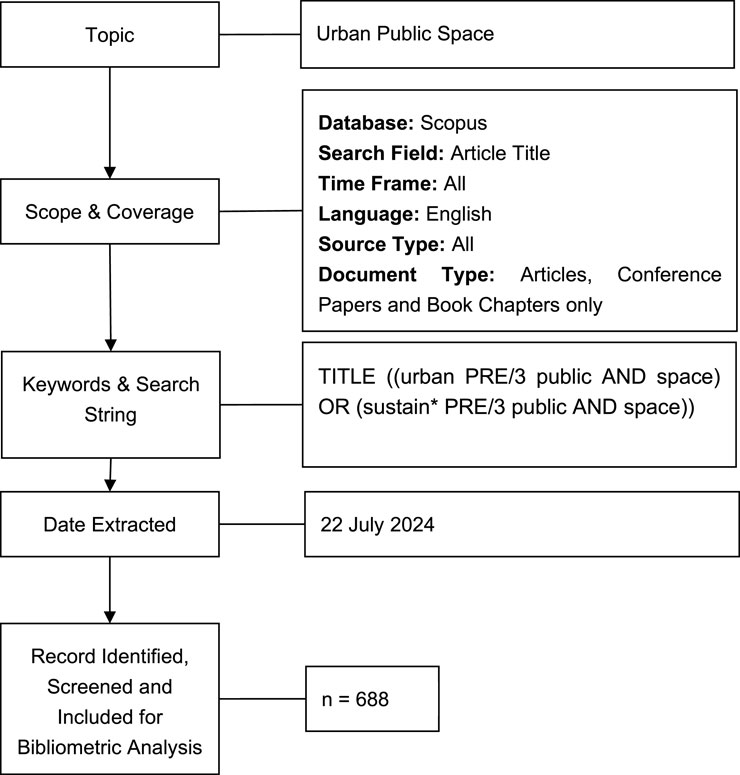
Figure 1. Flow diagram of the search strategy. Source: Zakaria et al. (2021), Moher et al. (2009).
To enhance the precision of the search and maintain focus on the research subject, the search parameters were restricted to article titles, thereby encapsulating studies explicitly centred on urban public space development. No temporal restrictions were applied, allowing for a comprehensive retrieval of literature spanning the entire available body of work. This methodology facilitates a broad and integrated understanding of the field’s evolution over time. The inclusion criteria for the dataset were not limited by language, enabling the incorporation of research published in diverse languages and thereby broadening the scope to encompass global perspectives. The selection of document types was restricted to articles, conference papers, and book chapters, ensuring a focus on textually detailed and substantive forms of scholarly discourse most likely to contribute meaningfully to both theoretical and practical developments within the field.
A meticulously designed search string was developed, integrating the term “urban public space” and utilizing Boolean operators to filter out less pertinent document types. This deliberate approach facilitated a focused yet comprehensive examination of the database, ensuring the integrity and depth of the bibliometric analysis. The data extraction date, explicitly recorded as 22 July 2022, establishes a precise temporal framework, enhancing the research’s reproducibility. A total of 688 records were identified and evaluated for inclusion, representing a significant volume of literature for subsequent bibliometric investigation. This flow diagram, drawing inspiration from the studies of Zakaria et al. (2021) and Moher et al. (2009), represents a methodologically robust, transparent, and reproducible search framework critical for upholding the credibility of bibliometric research. It functions both as a foundational model for the current analysis and as a reference point for future scholarly efforts seeking to synthesize knowledge and evaluate trends in the field of urban public space development.
3.2 Data cleaning, harmonization, and tools
The bibliometric analysis demands a meticulous process of data cleaning and standardization to ensure precision and dependability. In this research, advanced features of OpenRefine and biblioMagika (Ahmi, 2023) were utilized to systematically process and organize data retrieved from Scopus. The process began with downloading the Scopus dataset in. csv format, followed by a detailed examination of essential columns such as author names, affiliations, and keywords. Advanced clustering techniques were applied to identify and resolve inconsistencies within the data. Once the automated cleaning was completed, a comprehensive manual review was conducted to validate the corrected keywords and merge cells containing multiple entries. This stage was critical for restoring data integrity after segmentation. Finally, the refined and harmonized dataset was converted back to its original format, ready for further detailed analysis.
The research progressed into the analytical phase, incorporating biblioMagika (Ahmi, 2023) to refine the bibliometric analysis by standardizing data on authorship, institutional affiliations, and countries. This process was further supported by OpenRefine, which enhanced the accuracy of keyword data (Ahmi, 2023b). The findings were visualized through VOSviewer (van Eck and Waltman, 2004) that effectively illustrated the conceptual network within the study. By integrating these methodologies, the analysis provided a holistic and detailed exploration of the research landscape in urban public space development.
3.3 Validation and reliability
The validity and reliability of the results in this bibliometric analysis are influenced by the exclusive use of the Scopus database. Scopus is widely recognized for its extensive and high-quality indexing of peer-reviewed literature, which enhances the reliability of data extracted for trend analysis, citation metrics, and thematic mapping (Fayad et al., 2024; Punj et al., 2023; Mansour et al., 2022). To reduce duplication and errors, data cleaning was performed using OpenRefine and harmonization techniques in biblioMagika, ensuring consistency in author names, affiliations, and keywords. The use of multiple bibliometric tools (e.g., co-occurrence analysis, MCA, keyword evolution mapping) ensured triangulation, enhancing construct validity. No single software or metric was relied upon, and the findings were cross-validated through multiple indicators such as h-index, g-index, and citation per paper. Findings were interpreted in relation to established theoretical constructs (e.g., Lefebvre’s “right to the city”, publicness theory, social inclusion frameworks), ensuring conceptual validity. Themes from the data were compared against emergent global urbanism discourses, confirming alignment and surfacing novel insights.
Although this study relied solely on Scopus, efforts were made to enhance its generalizability. By including data from 1975 to 2024, the study captures long-term scholarly evolution, allowing temporal generalization. With contributions from social sciences, engineering, environmental science, and humanities, findings are relevant across disciplines. The flow diagram and search strategy support reproducibility by other researchers.
However, limiting the data source to Scopus introduces a potential constraint on validity, as it may exclude relevant publications indexed in other reputable databases such as Web of Science, Google Scholar, or regional repositories. This may result in a partial view of the scholarly landscape, particularly underrepresenting contributions from certain regions. Despite this limitation, the methodological consistency and the use of advanced bibliometric tools support the internal reliability of the findings. To strengthen external validity in future studies, incorporating multiple databases is recommended. This methodological framework can be adapted and applied in other research or policy domains. It can be used to map trends in sustainable housing, public transport, informal settlements, or climate-resilient infrastructure. Regions or cities can replicate the method using local databases or specific keywords to generate context-specific insights. Governments can use bibliometric trend mapping to evaluate whether their planning policies align with global research and innovation.
4 Findings
4.1 Documents profiles
The documents retrieved from Scopus and analysed for this study are summarized in Table 2 below. The table reveals that the initial Scopus publication on urban public space dates back to 1975, and as such, the data spanning from 1975 to 2024 were utilized for this investigation. A total of 688 publications authored by 1,659 individuals accrued 11,165 citations during this period, resulting in an h-index of 41.
Furthermore, Table 3 below illustrates the categories of documents from which the data utilized in this study were derived. As indicated in the table, most of the data (65.12%) was sourced from journal articles, followed by conference proceedings (17.15%), book chapters (12.06%), reviews (3.34%), and books (0.58%).
The final determinant in identifying a prevailing trend, following document type, is the subject area, which reflects the academic fields that have acknowledged the development of urban public space. This analysis categorizes the published works, as presented in Table 4, according to their respective subject areas. The literature distribution on urban public space reveals a broad presence across several disciplines, with the highest representation in the social sciences (56.25%), followed by engineering (28.78%), environmental sciences (25.29%), arts and humanities (16.28%), and computer sciences (13.08%).
4.2 Publication trends
Figures 2, 3 illustrate the temporal progression of research in urban public space, highlighting a consistent increase in both the volume of publications and citations over time. This bibliometric analysis, spanning from 1975 to 2024, offers a longitudinal view of scholarly engagement with the field and its reception within the academic community. Beginning with a single publication in 1975, there has been a significant upward trajectory in research output, culminating in 2023 with 76 publications. This trend indicates a growing scholarly interest and an expansion of research endeavors in the domain of urban public space development.
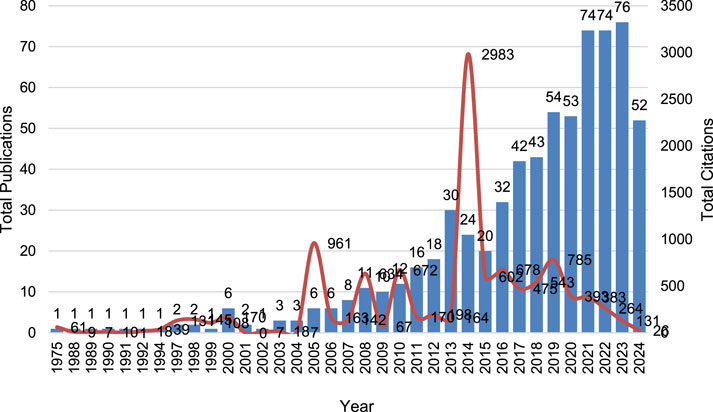
Figure 2. Total Publications and Citations by Year Source: Generated by the author(s) using biblioMagika® (Ahmi, 2024).
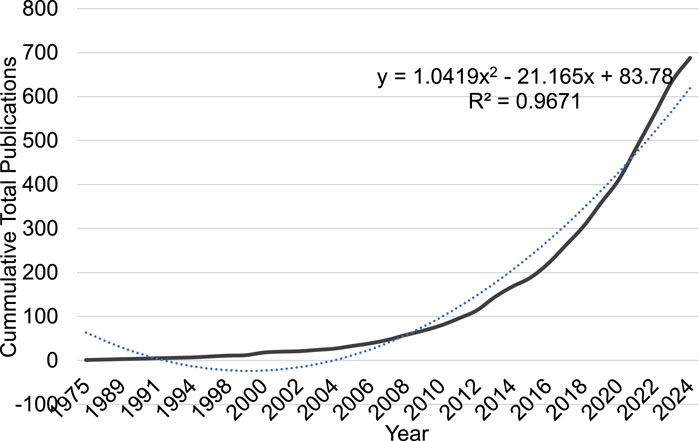
Figure 3. Total Publications and Citations by Year. Source: Generated by the author(s) using biblioMagika® (Ahmi, 2024).
4.3 Publications by authors
Table 5 offers a comprehensive analysis of the leading authors in the domain of urban public space, highlighting their academic contributions through a range of bibliometric measures. By concentrating on scholars with a minimum of four publications, the table underscores both the quantity of their research outputs and their scholarly impact, as reflected in citation metrics and broader academic recognition. At the forefront is Kang Jian from the University College London in the United Kingdom, with 16 publications and a total of 222 citations. This indicates a significant contribution to the body of literature, with a few of these works resonating within the scholarly community, as demonstrated by a high h-index of 3. Closely following is Botteldooren, Dick from Ghent University, Belgium, whose six publications have amassed 232 citations, reflecting a considerable impact as well, with an h-index of 2. Few more authors from the same institution underscores the global nature of urban public space research. For instance, De Coensel, Bert from Ghent University, Belgium, shows a strong citation per publication ratio, suggesting that his work is not only voluminous but also influential. Similarly, Van Renterghem, Timothy and Sun Kang from the same institution ‘Ghent University’ in Belgium exhibit high citation metrics, indicative of the far-reaching impact and international recognition of their research.
Bibliometric indicators, including the h-index, g-index, and m-index, provide a nuanced evaluation of research output. The h-index measures an author’s productivity and scholarly impact by quantifying the number of publications cited at least h times (Chadegani et al., 2013). The g-index extends this by recognizing authors whose works have garnered a higher volume of citations, while the m-index normalizes the h-index by considering the duration of an author’s active research career, thereby indicating the rate of impactful contributions. Together, these metrics not only underscore individual researchers’ scholarly contributions but also reflect the academic focus and research excellence of their affiliated institutions. This data offers a comprehensive perspective on scholarly influence in the domain of urban public space, identifying prominent contributors and thought leaders who are shaping the progression of the field.
4.4 Publications by institutions
In the field of urban public space studies, institutional contributions are critical in fostering research advancement and knowledge dissemination. Table 6 provides a detailed list of the most prolific institutions; each having published at least ten scholarly articles. Ghent University in Belgium emerges as the leading institution in terms of publication volume, reflecting a concentrated hub of research activity in the region. However, when evaluating research impact through citation metrics, the University of California (USA), the University of Sheffield (UK), and the University of Melbourne (Australia) distinguish themselves with notably high average citation counts per publication. This highlights not only the quantity of research produced but also the extent to which the academic community recognizes and values these contributions. This data emphasizes the global and diverse nature of urban public space research, showcasing not only the substantial academic output but also the significant influence and engagement these institutions maintain within the broader scholarly community.
4.5 Publications by country
The bibliometric analysis outlined in Table 7 provides insights into the international distribution and influence of research on urban public spaces, as reflected in the academic outputs of different nations. Utilizing a range of bibliometric metrics, the study evaluates the scientific contributions of each country, offering a comprehensive perspective on the scope and impact of this body of research. China emerges as the most prolific contributor with 487 publications, followed by the United Kingdom, United States, Belgium, and Australia, indicating a vibrant and diverse geographic distribution of research activity within the domain. However, the United States, Australia, and the United Kingdom lead in citation metrics, suggesting that while China has a substantial output, the research from the aforementioned countries exerts greater influence on the academic community, as reflected in higher citation counts.
The h-index reveals that the United Kingdom, China, and the United States are leading in terms of academic productivity, with indices of 26, 25, and 23, respectively. This suggests that a significant proportion of publications from these nations have been frequently cited. The g-index, which emphasizes the influence of highly cited works, reinforces this trend, highlighting the substantial impact of research from these countries. The m-index offers additional insight, with China emerging as the leader, followed by Australia and Belgium, registering m-indices of 1.250, 1.222, and 1.176, respectively. These figures suggest that research contributions from these countries are rapidly recognized and cited within the academic community.
4.6 Publications by source title
Table 8 and Figure 4 outline the primary academic journals and conference series that represent the most active platforms for the dissemination of research in urban public space. These sources are identified based on having published at least four works within this domain, accompanied by a range of bibliometric measures that indicate the breadth and scholarly impact of the research featured. “Sustainability (Switzerland)” stands out as the leading publication, with 25 articles and an impressive citation total of 275, highlighting its pivotal role in shaping the discourse surrounding urban public space. The journal’s influence is further emphasized by an h-index of 10, suggesting that many of its articles have received frequent citations, thereby underscoring both the quality and the scholarly significance of the research it publishes.
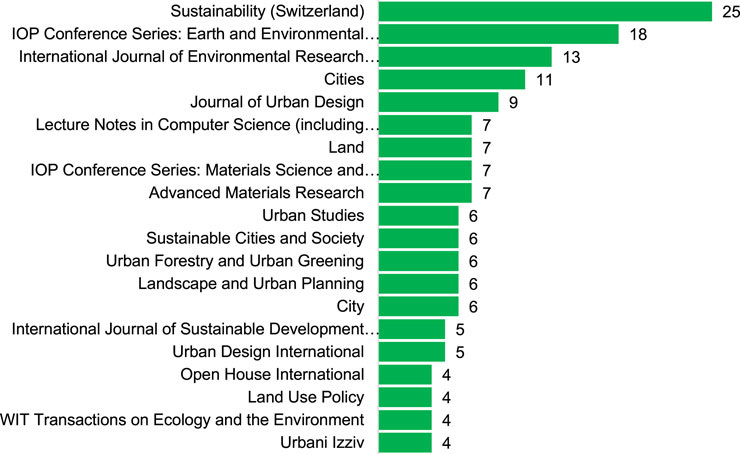
Figure 4. Top 20 Most Productive Source Title Source: Generated by the author(s) using biblioMagika® (Ahmi, 2024).
4.7 Highly cited documents
Table 9 presents a bibliometric analysis of the 20 most highly cited articles in the field of urban public space. This analysis underscores the scholarly influence of these pivotal works while also illustrating the thematic trends that have attracted substantial academic interest. The articles are ranked based on their total citation count, with additional insights provided through average annual citation rates, offering a temporal lens on their enduring significance within the discipline. At the apex of this list is Wolch, Byrne, and Newell (2014) pivotal work on urban green space, public health, and environmental justice: The challenge of making cities ‘just green enough’, published in Landscape and Urban Planning. This article has resonated profoundly within the academic community, as evidenced by its 2629 citations, averaging 239.00 citations per year, indicating its foundational influence on the research that followed.
Amin’s (2008) examination of collective culture and urban public space, and Yang and Kang’s (2005) work on acoustic comfort evaluation in urban open public spaces are also notably influential, with citations reflecting their enduring impact over the years. These works have served as cornerstones in defining and advancing the concept urban public space. The inclusion of Kang and Zhang’s (2010) research on semantic differential analysis of the soundscape in urban open public spaces and Yang and Kang’s (2005) work on acoustic comfort evaluation in urban open public spaces highlights the study and understanding of how sound interacts with and influence the environment, as well as how it is perceived by individuals and communities. Amin’s (2008) examination of collective culture and urban public space and Low et al.’s (2005) study on rethinking urban parks: public space and cultural diversity emphasize the concerns of cultural differences in urban public spaces.
The table further includes works that delve into public health, environmental justice, and inequalities in urban public spaces. For instance, Wolch et al.’s (2014) work on urban green space, public health, and environmental justice: The challenge of making cities ‘just green enough’, Koohsari et al.’s (2015) work on public open space, physical activity, urban design and public health: Concepts, methods and research agenda, and You’s (2016) work on characterizing the inequalities in urban public green space provision in Shenzhen, China. Each entry in this bibliometric compilation represents a notable contribution to the existing body of knowledge, collectively mapping the intellectual progression of urban public spaces. The articles function as reference points for contemporary research, providing a valuable resource for both academic and professional fields. They serve as a guide for future investigations and inform the ongoing development of urban public spaces. As a collection of highly cited works, this compilation not only documents the historical development of urban public space research but also outlines the directions for its future exploration.
4.8 Keywords co-occurrence analysis
The overlay visualization map presented in Figure 5 employs a rainbow colour gradient to represent the temporal progression of research themes in sustainable construction, as determined by the co-occurrence of author keywords. This approach enhances bibliometric analysis by highlighting thematic clusters and their interconnections, offering a dynamic view of the chronological development, evolving research priorities, and emerging trends within the field. By integrating the temporal dimension into keyword networks, overlay visualization maps extend the capabilities of co-occurrence analysis, providing a more comprehensive understanding of the field’s evolution (Jan van Eck and Waltman, 2021). In Figure 5, the rainbow colour scheme represents the research timeline, with a gradient transition across the spectrum—red typically indicating earlier studies and violet denoting more recent publications. This color-coding approach facilitates an immediate visual understanding of the temporal distribution of research themes, offering valuable insights into the evolution and current focus areas of the field. The overlay visualization map, employing this rainbow scheme, provides a detailed depiction of temporal trends in sustainable construction research. The progression of keywords from red to violet reflects a shift from foundational theories to recent developments and emerging sustainability challenges, highlighting the field’s progression from traditional practices to innovative technologies.
4.9 Summary of findings
The bibliometric analysis reveals a steady and significant growth in urban public space research from 1975 to 2024. A total of 688 publications by 1,659 authors accumulated 11,165 citations, with an h-index of 41, reflecting strong scholarly influence. The field experienced gradual growth, peaking in 2023 with 76 publications. China leads global research contributions with 487 publications, followed by the UK, USA, Belgium, and Australia, indicating broad international engagement. Ghent University (Belgium) stands out as the most active institution, while Kang Jian from University College London ranks as the most prolific author. The journal Sustainability (Switzerland) dominates publication volume and impact, contributing 25 papers and 275 citations. Notably, the highly cited work by Wolch, Byrne, and Newell (2014) on urban green spaces, public health, and environmental justice shapes ongoing academic discourse. This study offers a comprehensive, long-term bibliometric analysis (1975–2024) of urban public space research, mapping thematic evolutions, leading contributors, and global research trends. It uniquely identifies key authors, institutions, and journals shaping the field, while highlighting China’s emerging dominance. The work provides a valuable reference for future research direction, policy formulation, and urban planning strategies.
5 Discussion
This bibliometric study set out to examine global research trends in UPS development between 1975 and 2024. The results demonstrate a growing scholarly interest in the topic, with notable geographical, thematic, and institutional patterns. This section interprets the findings considering previous studies, identifies knowledge gaps, and discusses the broader implications for urban planning and research, particularly from a comparative global perspective.
5.1 Trends in scholarly output and thematic evolution
The steady increase in UPS development publications–peaking at 76 in 2023 – confirms hypothesis one and aligns with global urbanization pressures and policy frameworks such as the United Nation’s Sustainable Development Goals (SDGs), particularly SDG 11 on inclusive, safe, and sustainable cities. This upward trend supports the findings of Zhang et al. (2020), who noted a similar trajectory in green space and health-related research, and Chen and Chen (2022), who observed growing interest in community-level public spaces. The study’s keyword co-occurrence and thematic evolution analysis revealed a transition from classical spatial planning and urban form towards themes such as public health, social justice, acoustic comfort, and smart urbanism. This reflects a broader shift in urban research highlighted by Carmona (2015) and Haas and Olsson (2014), who argue for re-theorizing public space to incorporate emergent urban realities, including digital infrastructure, participatory governance, and climate resilience.
5.2 Geographical distribution and institutional dominance
The findings confirm hypotheses two and four, revealing that most research output is concentrated in China, the United Kingdom, the United States, Belgium, and Australia. This reinforces previous concerns about the epistemic dominance of Global North institutions in urban studies (Kuymulu, 2013; Butler, 2012). China’s dominance is likely linked to rapid urbanization and increased research investment (Zhao and Ji, 2018), while European institutions, particularly Ghent University, demonstrate strong citation performance, reflecting research quality and influence. However, the Global South remains underrepresented in both the publication and citation metrics. This skews the academic discourse, potentially marginalizing the unique challenges and innovations emerging from developing contexts. As Watson (2009) and Turok and Borel-Saladin (2016) argue, urban realities in Africa and Latin America diverge significantly from Northern paradigms, necessitating distinct conceptual and methodological frameworks.
5.3 Underrepresentation and the case for broader inclusivity
While previous bibliometric reviews (e.g., Meng et al., 2020; Mohamed and van der Laag Yamu, 2023) provided focused insights on specific themes—such as campus space or green infrastructure—this study attempts a broader synthesis. Nonetheless, the geographical distribution of references still requires improvement. Most of the highly cited works are Euro-American, even though cities in the Global South face more acute issues related to informality, exclusion, and contested space (Low et al., 2005; McCann, 1999). For instance, in South Africa, research by Landman (2020) and Harrison and Todes (2015) has explored how spatial legacies of apartheid continue to shape public space accessibility and identity. In Brazil, scholars such as Caldeira (2017) have examined the “fortification” of public space in response to crime and inequality. In India, Mehta (2014) has interrogated the informal appropriation of streets as lived public spaces. These perspectives are essential to globalizing the discourse and ensuring context-sensitive urban policy recommendations.
5.4 Implications for theory, policy, and practice
This study’s findings highlight the need to revisit dominant theoretical frameworks, such as Lefebvre’s “right to the city,” considering contemporary urban transformations and global inequalities. While Lefebvre (1968) remains foundational, the work of Kuymulu (2013) and Mitchell (2014) warns that rights-based urban theories must be re-grounded in political and spatial struggles across diverse geographies. From a policy perspective, the concentration of UPSD research in elite institutions and journals suggests a risk of policy myopia, where global urban agendas overlook grassroots innovations. Expanding South-based research contributions could enhance the relevance and effectiveness of urban policy frameworks. Practically, urban planners and designers must move beyond Eurocentric best practices and engage with locally embedded knowledge, particularly in contexts where formal public space is contested, absent, or reimagined through informal or cultural practices.
6 Conclusion
The findings of this bibliometric analysis reveal that there has been a significant upward trajectory in research output, culminating in 2023 with 76 publications from just one in 1975. This trend indicates a gradual but accelerating scholarly interest and an expansion of research endeavours in the domain of urban public space development. The leading scholar, as revealed by the analysis, is Kang Jian from the University College London in the United Kingdom, with 16 publications and a total of 222 citations. However, Ghent University in Belgium emerges as the leading institution in terms of publication volume, reflecting a concentrated hub of research activity in the region. In terms of publication by country, China emerges as the most prolific contributor with 487 publications, followed by the United Kingdom, United States, Belgium, and Australia, indicating a vibrant and diverse geographic distribution of research activity within the domain. These publications are in diverse source titles with “Sustainability (Switzerland)” emerging is the leading source title in terms of the number of articles published over the years. Furthermore, the results of this analysis indicate that the work of Wolch, Byrne, and Newell on urban green space, public health, and environmental justice: The challenge of making cities ‘just green enough’, published in Landscape and Urban Planning as the most influential publication in the field of urban public space development.
The upward trajectory in research output reflects a gradual but accelerating recognition of the importance of urban public spaces in addressing global urban challenges. This trend aligns with broader concerns about urban sustainability, liveability, and equity, as cities worldwide face increased pressures from rapid urbanization and environmental degradation. China’s leadership in publication volume may be attributed to its rapid urbanization and policy emphasis on sustainable urban development, while the contributions from Western countries reflect their long-standing tradition of research in urban studies and planning. This diversity suggests that urban public space development is a global concern, influenced by unique regional challenges and priorities. The substantial growth in the volume of publications and citations over time highlights the rising importance of the urban public space domain. The sustained focus on themes such as public health, environmental justice, cultural diversity, social inequality, and acoustic comfort underscores the necessity for continued investment in these critical areas by the industry. While certain regions, such as China and Europe, dominate the field, underrepresented areas, particularly in the Global South, may hold valuable insights into unique challenges and innovations. Collaborative efforts can help bridge these gaps. Despite the progress, gaps remain in addressing the equity and accessibility of urban public spaces in marginalized communities. Future research could focus on integrating technological advancements (e.g., smart cities) and exploring the socio-cultural dimensions of urban public spaces to ensure inclusivity and adaptability.
The global imbalance in research output calls for increased investment in urban research in the Global South, capacity building in local institutions, and greater inclusion of diverse urban experiences in global academic platforms. This is essential to ensure that urban planning policies and practices are equitable, inclusive, and responsive to the needs of cities worldwide.
The bibliometric trends reveal a growing maturity in the field of urban public space development, with promising areas for continued exploration. By leveraging these insights, scholars and practitioners can further advance the domain, addressing both regional and global urban challenges with innovative and inclusive solutions. This study is the first to integrate a long-term (1975–2024) multi-dimensional bibliometric evaluation of urban public space development using advanced tools like BiblioMagika and VOSviewer. It contributes a unique global perspective the uncovers both geographic imbalances and thematic evaluation–offering a benchmark for future urban public space development research and policy alignment.
Data availability statement
The original contributions presented in the study are included in the article/supplementary material, further inquiries can be directed to the corresponding author.
Author contributions
KN: Writing – original draft, Writing – review and editing. SM: Conceptualization, Methodology, Supervision, Writing – review and editing. TM: Conceptualization, Methodology, Writing – review and editing.
Funding
The author(s) declare that no financial support was received for the research and/or publication of this article.
Conflict of interest
The authors declare that the research was conducted in the absence of any commercial or financial relationships that could be construed as a potential conflict of interest.
Publisher’s note
All claims expressed in this article are solely those of the authors and do not necessarily represent those of their affiliated organizations, or those of the publisher, the editors and the reviewers. Any product that may be evaluated in this article, or claim that may be made by its manufacturer, is not guaranteed or endorsed by the publisher.
References
Ahmi, A. (2023). “OpenRefine: an approachable tool for cleaning and harmonizing bibliographical data,” in 11th international conference on applied science and technology 2022 (11th ICAST 2022) AIP conference proceedings, 2827. doi:10.1063/5.0164724AIP Conf. Proc.
Ahmi, A. (2024). biblioMagika. Available online at: https://aidi-ahmi.com/index.php/bibliomagika.
Amin, A. (2008). Collective culture and urban public space. City 12 (1), 5–24. doi:10.1080/13604810801933495
Anderson, J., Ruggeri, K., Steemers, K., and Huppert, F. (2017). Lively social space, well-being activity, and urban design: findings from a low-cost community-led public space intervention. Environ. Behav. 49 (6), 685–716. doi:10.1177/0013916516659108
Arboix, I. S., and Martín, E. (2017). Public space in barcelona (1992-2017)-evolution and case studies. IOP Conf. Ser. Mater. Sci. Eng. 245 (5), 052089. doi:10.1088/1757-899X/245/5/052089
Baraibar-Diez, E., Luna, M., Odriozola, M. D., and Llorente, I. (2020). Mapping social impact: a bibliometric analysis. Sustainability. doi:10.3390/su12229389
Butler, C. (2012). Henri Lefebvre: spatial politics, everyday life and the right to the city. 1st ed. London: Routledge-Cavendish. doi:10.4324/9780203880760
Carmona, M. (2015). Re-theorising contemporary public space: a new narrative and a new normative. J. Urbanism 8 (4), 373–405. doi:10.1080/17549175.2014.909518
Çelik, E., Sungur, A., and Türkyılmaz, Ç. C. (2024). Exploring the relationship between healthy city and public space ergonomics: a bibliometric analysis. Proc. Int. Conf. Contemp. Aff. Archit. Urbanism-ICCAUA 7 (1), 1370–1382. doi:10.38027/iccaua2024en0223
Chadegani, A. A., Salehi, H., Yunus, M. M., Farhadi, H., Fooladi, M., Farhadi, M., et al. (2013). A comparison between two main academic literature collections: Web of Science and Scopus databases. arXiv Prepr. arXiv:1305.0377 9. doi:10.5539/ass.v9n5p18
Chen, Y., and Chen, J. (2022). A dynamic analysis of the research on community public space and facilities based on the perspective of bibliometrics. J. Humanit. Soc. Sci. Stud. 4, 42–50. doi:10.32996/jhsss.2022.4.1.4
Dissanyake, C., and Weerasinghe, U. G. (2021). Urban microclimate and outdoor thermal comfort of public spaces in warm-humid cities: a comparative bibliometric mapping of the literature. Am. J. Clim. Change. doi:10.4236/ajcc.2021.104023
Dong, J. Y., Cheng, W., Ma, C. P., Tan, Y. T., and Xin, L. S. (2017). On public space design for Chinese urban residential area based on integrated architectural physics environment evaluation. In IOP Conference Series: Earth and Environmental Science, Thailand, (61, 1, 012034). doi:10.1088/1755-1315/61/1/012034
Dong, W., Wu, J., Chen, Y., and Zhou, X. (2023). A bibliometric review of research on the perceptions of campus public spaces. Buildings 13, 501. doi:10.3390/buildings13020501
Fayad, A. A., Binti Mohd Ariff, A. H., Ooi, S. C., Ahmi, A., and Khatib, S. F. (2024). Towards concise reporting through integrated reporting: a bibliometric review. Meditari Account. Res. 32 (3), 832–856. doi:10.1108/medar-10-2021-1470
Haas, T., and Olsson, K. (2014). Transmutation and reinvention of public spaces through ideals of urban planning and design. Space Cult. 17 (1), 59–68. doi:10.1177/1206331213493855
Kang, J., and Zhang, M. (2010). Semantic differential analysis of the soundscape in urban open public spaces. Build. Environ. 45 (1), 150–157. doi:10.1016/j.buildenv.2009.05.014
Karaçor, E. K., and Ögçe, H. (2023). Evaluating the publicness dimension of public space with bibliometric analysis. Future Cities Environ. doi:10.5334/fce.192
Ke, Y., Wang, S., Chan, A. P., and Cheung, E. (2009). Research trend of public-private partnership in construction journals. J. Constr. Eng. Manag. 135 (10), 1076–1086. doi:10.1061/(asce)0733-9364(2009)135:10(1076)
Koohsari, M. J., Mavoa, S., Villanueva, K., Sugiyama, T., Badland, H., Kaczynski, A. T., et al. (2015). Public open space, physical activity, urban design and public health: concepts, methods and research agenda. Health and place 33, 75–82. doi:10.1016/j.healthplace.2015.02.009
Kuymulu, M. B. (2013). The vortex of rights: ‘right to the city’ at a crossroads. Int. J. Urban Regional Res. 37, 923–940. doi:10.1111/1468-2427.12008
Lewandowska, A. (2018). ‘Architectural and urban design of public space based on social cooperation’, 9, 187–194. doi:10.15503/jecs20182.187.194
Low, S., Taplin, D., and Scheld, S. (2005). Rethinking urban parks: public space and cultural diversity. United States: University of Texas Press.
Mansour, A. A. Z., Ahmi, A., Popoola, O. M. J., and Znaimat, A. (2022). Discovering the global landscape of fraud detection studies: a bibliometric review. J. Financial Crime 29 (2), 701–720. doi:10.1108/jfc-03-2021-0052
McCann, E. J. (1999). Race, protest, and public space: contextualizing Lefebvre in the U.S. City. Antipode 31, 163–184. doi:10.1111/1467-8330.00098
Meng, L., Wen, K. H., Brewin, R., and Wu, Q. (2020). “Knowledge atlas on the relationship between urban street space and residents’ health—a bibliometric analysis based on VOSviewer and CiteSpace,”, 12. Sustainability, 2384. doi:10.3390/su12062384
Mitchell, D. (2014). On the end and ends of public space. Work. Pap. Se (06). doi:10.1353/anq.2012.0061
Mohamed, A. A., and van der Laag Yamu, C. (2023). Space syntax has come of age: a bibliometric review from 1976 to 2023. J. Plan. Literature 39, 203–217. doi:10.1177/08854122231208018
Moher, D., Liberati, A., Tetzlaff, J., and Altman, D. G.Prisma Group (2009). Preferred reporting items for systematic reviews and meta-analyses: the PRISMA statement. PLoS Med. 6 (7), e1000097. doi:10.1371/journal.pmed.1000097
Nikšič, M., and Sezer, C. (2017). Public space and urban justice. Built Environ. 43 (2), 165–172. doi:10.2148/benv.43.2.165
Nykiforuk, C. I., Osler, G. E., and Viehbeck, S. M. (2010). The evolution of smoke-free spaces policy literature: a bibliometric analysis. Health policy 97 (1), 1–7. doi:10.1016/j.healthpol.2010.03.001
Pancholi, S., Yigitcanlar, T., and Guaralda, M. (2015). Public space design of knowledge and innovation spaces: learnings from kelvin grove urban village, brisbane. J. Open Innovation Technol. Mark. Complex. 1 (1), 1–17. doi:10.1186/s40852-015-0015-7
Punj, N., Ahmi, A., Tanwar, A., and Abdul Rahim, S. (2023). Mapping the field of green manufacturing: a bibliometric review of the literature and research frontiers. J. Clean. Prod. 423 (138729), 138729–22. doi:10.1016/j.jclepro.2023.138729
Rahman, N. A. A., Ahmi, A., Jraisat, L., and Upadhyay, A. (2022). Examining the trend of humanitarian supply chain studies: pre, during and post COVID-19 pandemic. J. Humanit. Logist. Supply Chain Manag. 12 (4), 594–617. doi:10.1108/jhlscm-01-2022-0012
Simm, W., Ferrario, M. A., Whittle, J., Davenport, R., Binner, J., Frankova, K., et al. (2016). On the role of digital consultation tools in public space design: a case study. Interact. Comput. 28 (3), 273–292. doi:10.1093/iwc/iwu042
Singh, V. K., Singh, P., Karmakar, M., Leta, J., and Mayr, P. (2021). The journal coverage of Web of Science, Scopus and Dimensions: a comparative analysis. Scientometrics 126, 5113–5142. doi:10.1007/s11192-021-03948-5
Smith, S., and Steino, N. (2016). “Public space design between alienation and appropriation: the case of parkour,” in Time, space and the human body.
Southworth, M. (2014). Public life, public space, and the changing art of city design. J. Urban Des. 19 (1), 37–40. doi:10.1080/13574809.2014.854684
Wolch, J. R., Byrne, J., and Newell, J. P. (2014). Urban green space, public health, and environmental justice: the challenge of making cities ‘just green enough. Landsc. urban Plan. 125, 234–244. doi:10.1016/j.landurbplan.2014.01.017
Yang, W., and Kang, J. (2005). Acoustic comfort evaluation in urban open public spaces. Appl. Acoust. 66 (2), 211–229. doi:10.1016/j.apacoust.2004.07.011
You, H. (2016). Characterizing the inequalities in urban public green space provision in Shenzhen, China. Habitat Int. 56, 176–180. doi:10.1016/j.habitatint.2016.05.006
Zakaria, R., Ahmi, A., Ahmad, A. H., Othman, Z., Azman, K. F., Ab Aziz, C. B., et al. (2021). Visualising and mapping a decade of literature on honey research: a bibliometric analysis from 2011 to 2020. J. Apic. Res. 60 (3), 359–368. doi:10.1080/00218839.2021.1898789
Zhang, J., Yu, Z., Zhao, B., Sun, R., and Vejre, H. (2020). Links between green space and public health: a bibliometric review of global research trends and future prospects from 1901 to 2019. Environ. Res. Lett. 15, 063001. doi:10.1088/1748-9326/ab7f64
Zhao, X., and Ji, Y. (2018). The urban public space betterment and land use sustainability under the human behavior. IOP Conf. Ser. Earth Environ. Sci. 113 (1), 012143. doi:10.1088/1755-1315/113/1/012143
Keywords: urban public space development, bibliometric analysis, thematic evolution, sustainable practice, publication trends
Citation: Ntakana K, Mbanga S and Mosiea T (2025) Urban public space development: themes and trends in the urban planning rhetoric. Front. Built Environ. 11:1456638. doi: 10.3389/fbuil.2025.1456638
Received: 28 June 2024; Accepted: 26 June 2025;
Published: 15 July 2025.
Edited by:
Assed N. Haddad, Federal University of Rio de Janeiro, BrazilReviewed by:
Martina Ferrando, Polytechnic University of Milan, ItalyFermanto Lianto, Tarumanagara University, Indonesia
Copyright © 2025 Ntakana, Mbanga and Mosiea. This is an open-access article distributed under the terms of the Creative Commons Attribution License (CC BY). The use, distribution or reproduction in other forums is permitted, provided the original author(s) and the copyright owner(s) are credited and that the original publication in this journal is cited, in accordance with accepted academic practice. No use, distribution or reproduction is permitted which does not comply with these terms.
*Correspondence: Khululekani Ntakana, a250YWthbmFAdWouYWMuemE=
 Khululekani Ntakana
Khululekani Ntakana Sijekula Mbanga
Sijekula Mbanga Tshepang Mosiea3
Tshepang Mosiea3